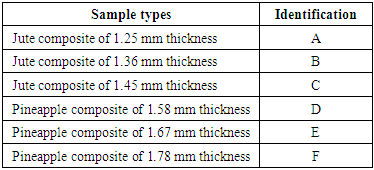-
Paper Information
- Paper Submission
-
Journal Information
- About This Journal
- Editorial Board
- Current Issue
- Archive
- Author Guidelines
- Contact Us
International Journal of Composite Materials
p-ISSN: 2166-479X e-ISSN: 2166-4919
2017; 7(2): 72-76
doi:10.5923/j.cmaterials.20170702.04

Tensile and Water Absorption Properties of Jute and Pineapple Fabric Reinforced Polyester Composite
Md. Reazuddin Repon 1, 2, K. Z. M. Abdul Motaleb 1, M. Tauhidul Islam 1, 2, Rajib Al Mamun 1, Md. Mizanur Rahman Mithu 3
1Department of Textile Engineering, Khwaja Yunus Ali University, Sirajgonj, Bangladesh
2Department of Textile Engineering, Mawlana Bhashani Science and Technology University, Tangail, Bangladesh
3Department of Mechanical Engineering, Khwaja Yunus Ali University, Sirajgonj, Bangladesh
Correspondence to: Md. Reazuddin Repon , Department of Textile Engineering, Khwaja Yunus Ali University, Sirajgonj, Bangladesh.
| Email: |  |
Copyright © 2017 Scientific & Academic Publishing. All Rights Reserved.
This work is licensed under the Creative Commons Attribution International License (CC BY).
http://creativecommons.org/licenses/by/4.0/

The role of natural fibers reinforced hybrid composite materials is growing at an increasing rate in the field of engineering and technology due to their considerable properties. The objective of this study is to examine the tensile strength, elongation percentage, Young’s modulus and water absorption percentage of jute and pineapple fabric reinforced polyester composite. Unsaturated polyester resin was used as matrix material. The properties of manufactured composite were evaluated experimentally using computerized UTM machine according to ASTM standards. The results revealed that the tensile properties were increased with the increase of composite thickness. The values of tensile strength and Young’s modulus of pineapple fabric composite were exhibited higher than the jute composite and the quite opposite trend were observed in case of elongation and water absorption percentage.
Keywords: Tensile properties, Water absorption, Jute fabric, Pineapple fabric, Polyester resin, Composite
Cite this paper: Md. Reazuddin Repon , K. Z. M. Abdul Motaleb , M. Tauhidul Islam , Rajib Al Mamun , Md. Mizanur Rahman Mithu , Tensile and Water Absorption Properties of Jute and Pineapple Fabric Reinforced Polyester Composite, International Journal of Composite Materials, Vol. 7 No. 2, 2017, pp. 72-76. doi: 10.5923/j.cmaterials.20170702.04.
Article Outline
1. Introduction
- Composites are a versatile and valuable family of materials that can solve problems of different applications and facilitate the introduction of new properties in materials [1]. In recent years, there has been an increasing interest in finding new applications of natural fibre reinforced composites. Natural fibres appear to be the outstanding materials which come as the viable and abundant substitute for the expensive and nonrenewable synthetic fibre. Natural fibre is promising reinforcement for use in composites on account of its low cost, low density, stiffness, high specific strength and modulus, no health risk, easy and safe handling, light weight, easy availability, renewability, non-abrasiveness, easy processing, non-toxicity, high flexibility, acoustic insulation and much lower energy requirement for processing [1, 2]. Natural fibers like sisal, banana, jute, oil palm, pineapple, kenaf and coir have been used as reinforcement in composite [3]. Natural fibre based composites are under intensive study due to their eco-friendly nature and peculiar properties such as acceptable specific properties, ease of separation, enhanced energy recovery, CO2 neutrality, biodegradability, and recyclable nature [4]. Among all of these natural fibres, Pineapple leaf fibres (PALF) have admirable mechanical properties. PALF is removed from the leaves of the plant Ananus cosmos. PALF is dominatingly comprised of cellulose (70–82%), lignin (5–12%) and ash (1.1%). The higher mechanical properties of pineapple fibre are associated with its high cellulose content and comparatively low micro-fibrillar angle [5].Another natural fibre, Jute performs comparatively better among the rice straw fibre, bagasse, stramineous fibre, cocos fibre, hemp, flax, ramie, banana, cotton, coir, sisal, etc., due to the inexpensive and commercial availability in a required form [6]. It can also be substituted for conventional fibres in many applications and has been applied as reinforcement to eco-composites and bio-composites [5]. Jute is an important bast fiber and comprises of bundled ultimate cells, each containing spirally oriented micro- fibrils bound together. Therefore, jute composites may exhibits outstanding mechanical properties and could be an ideal solution for wood substitution [1, 5].Many researchers have investigated the various mechanical, thermal and physical properties of pineapple and jute fibre reinforced composites [7-20]. Different matrix materials were used in different research. Among them, the commonly used matrixes are polyester resin [7, 10, 13, 17, 18, 19, 21], natural rubber [9], polypropylene [11, 13, 15], polyethylene [22-24], polycarbonate [25], epoxy resin [14, 23, 26], phenol formaldehyde [27]. It has been found that the mechanical and physical properties of jute and pineapple composites are highly inconsistent and depend on geographic origin of fibres, climatic growth conditions and processing techniques.The objective of this research work is to study the mechanical properties of jute and pineapple fabric by incorporating them into polyester resin matrix to prepare the composites at various volumes. The composites were tested to evaluate the tensile properties such as tensile strength, elongation percentage and Young’s modulus. Water absorption percentages were also investigated.
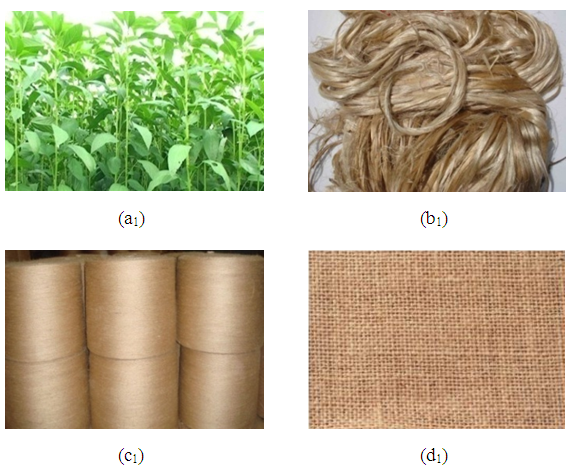 | Figure 1. (a1) Jute plant (b1) Jute fibre (c1) Jute yarn (d1) Jute fabric |
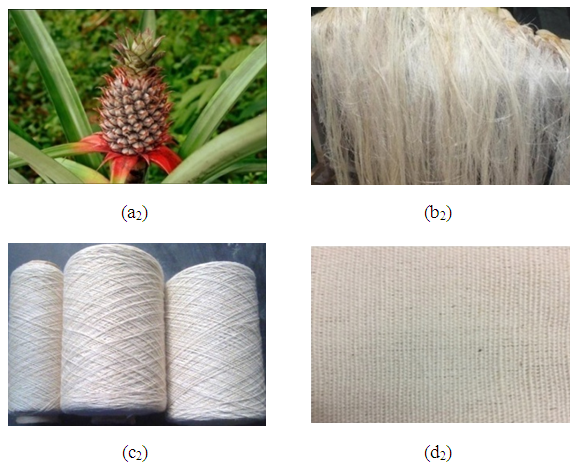 | Figure 2. (a2) Pineapple plant (b2) Pineapple fibre (c2) Pineapple yarn (d2) Pineapple fabric |
2. Materials and Methods
2.1. Materials
- Jute and pineapple fabrics having plain weave structures were collected from Bangladesh Jute Research Institute, Dhaka, Bangladesh. Unsaturated polyester resin and methyl ethyl ketone peroxide (MEKP) were purchased from Nasim Plastic Industries Limited, Dhaka, Bangladesh. MEKP was used as a catalyst.
|
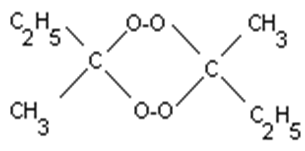 | Figure 3. Molecular structure of methyl ethyl ketone peroxide |
2.2. Methods
2.2.1. Sampling
- Thicknesses of samples were recorded by digital slide calipers. Average results of three readings from different place along the sample have taken for measuring the each thickness. Different samples are identified as mentioned table 2.
|
2.2.2. Fabrication of Composites
- Jute and Pineapple fabric reinforced polyester composites were prepared by hand layup technique [28]. Jute and Pineapple fabric were cut with a dimension of 30cm ×30 cm. A glass plate of the dimension 40cm ×40 cm was placed on a suitable place. A mylot paper with similar dimension to the glass plate was cut and placed on the glass plate. According to fabric weight, polyester resin was taken in a beaker and 2% MEKP was added. These two chemicals were mixed vigorously with an agitator. Half of the mixture was poured on to the mylot paper and spread over the area similar to the fabric with a plastic spreader. Then jute fabric was placed on to the polyester resin mixture and rolled with hand roller machine. Then rest of the mixture was poured on to the fabric and rolled. After it was covered with another mylot paper and rolled with the hand rolling machine to remove unwanted air bubbles and another glass plate was placed upon it. A dead weight of 15 kg was loaded on the arrangement for 4 hours. Finally the dead weight was unloaded and two layer of the mylot paper were separated from the composite. Thus, jute fabric reinforced polyester composite was obtained. Same process was followed to produce pineapple fabric composite. The amounts of polyester resin were varied for producing composite of different thicknesses.
 | Figure 4. Photographs of composite samples |
2.2.3. Testing of Samples
- The tensile properties such as tensile strength (TS), elongation at break percentage (EB%) and Young’s modulus (Y) of the prepared composites were evaluated by a universal testing machine (UTM) (Model: H50KS-0404, HOUNSFIELD, series S, UK) at Institute of Radiation and Polymer Technology Laboratory, Bangladesh Atomic Energy Commission, Dhaka, Bangladesh. The specimens were prepared according to ASTM D638 standard. Crosshead speed of 10 mm/min and a gauge length 50 mm were maintained. Equation 1, 2 and 3 were used for measuring the tensile strength, elongation at break percentage and Young’s modulus respectively [28].
 | (1) |
 | (2) |
 | (3) |
 | (4) |
3. Results and Discussion
3.1. Tensile Properties
3.1.1. Tensile Strength
- Figure 5 depicts the tensile strength of jute and pineapple fabric reinforced polyester composite. It is clearly evident from the figure 1 that with the increasing of the thickness, the tensile strength is increasing both for jute and pineapple fabric reinforced polyester composite. Regarding jute composite, the tensile strength of samples B and C were increased 35.28% and 52.92% respectively compared to the sample A. Concerning the tensile strength of pineapple fabric composite, the samples orders were found as D<E<F. The tensile strength was increased 2.48% for the sample E and 6.98% increased for the sample F compared to the sample D. The figure 1 also confirms that the tensile strength of pineapple fabric composite is higher than jute fabric composite. It is well known that composite strength mainly depends on fibre loading (%), fibre strength and interfacial strength between fibre and matrix. Tensile properties of composite give some indirect information about interfacial bonding between fibre and matrix.
 | Figure 5. Effect of tensile strength on jute and pineapple fabric reinforced polyester composite |
3.1.2. Elongation at Break
- The elongation percentages at break of jute and pineapple fabric reinforced polyester composite specimens are presented in figure 6. Regarding elongation% of jute fabric composite, the samples orders were found as A<B<C. The percentages of elongation at break were increased by 12.63% and 18.42% for the sample B and C correspondingly as compared to the sample A. Consequently, in pineapple fabric composite, the samples orders were found as D<E<F. The elongation% was increased 9.67% for the sample E and 62.91% increased for the sample F as compared to the sample D.
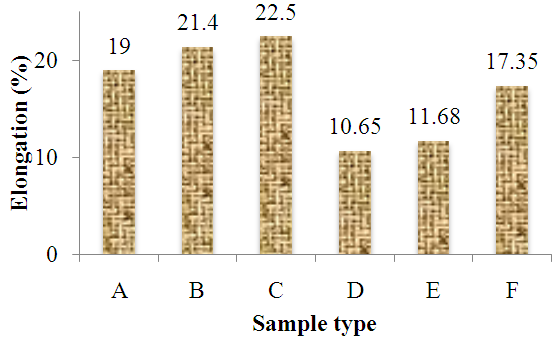 | Figure 6. Elongation% of jute and pineapple fabric reinforced polyester composite |
3.1.3. Young’s Modulus
- Figure 7 illustrates the Young’s modulus of jute and pineapple fabric reinforced polyester composite. The samples orders of jute fabric composite were found as A<B<C depending on Young’s modulus. The Young’s modulus of the samples B and C were increased by 18.34% and 40.89% respectively as compared to the sample A. Conversely, the Young’s modulus of the samples E and F were increased by 8.07% and 15.58% correspondently as compared to the sample D. The fibres of jute and pineapple form an intimate bond with polyester resin.
 | Figure 7. Effect of Young’s modulus on jute and pineapple fabric reinforced polyester composite |
3.2. Water Absorption
- Water absorption test is very important for determining degradability of the material in moist condition. The water absorption percentages of jute and pineapple fabric reinforced polyester composite specimens are shown in figure 8 for different soaking time. The water absorption percentages were increased with the increasing soaking time. The samples of jute fabric composite were exhibited higher water absorption than pineapple composite. This behavior was expected because the moisture regain of jute fibre is higher than the pineapple fibre. Besides, water can reside in composite due to other three reasons. Those are the lumen, the cell wall and the gaps between fibre and resin in the case of weak interface adhesion. The maximum water absorption (4.19%) was observed for the sample C at 60 minutes soaking time. It is well known that natural fibres are good water permeable as well as their composites. Hence, the water absorption characteristics of natural fibre composite is mainly fiber-controlled than the matrix [29, 30].
 | Figure 8. Effect of soaking time on water absorption properties of jute and pineapple composite |
4. Conclusions
- In this study, tensile and water absorption properties of jute and pineapple fabric reinforced polyester composites were investigated. The tensile strengths as well as Young’s modulus of pineapple composite were exhibited better results than that of the jute fabric reinforced composites. Opposite scenario has observed for elongation percentage at break. The capacity of water absorption was noticed higher in jute fabric composite than pineapple. The jute and pineapple fabric reinforced composites has degradable behaviors and can be used as environmental friendly materials. Further investigation will be done to improve processing, to expand the application fields for jute and pineapple composites.
 Abstract
Abstract Reference
Reference Full-Text PDF
Full-Text PDF Full-text HTML
Full-text HTML
